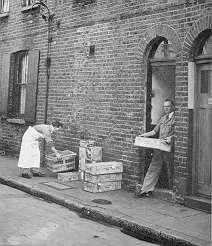|
Stepney |
|||||
In 1881, John James Sainsbury took over a shop at 68 Watney Street from his brother-in-law, Edward Staples. The shop sold cheese and salt bacon to the East End dockers and lightermen, who would stock up with bulk orders before setting off down the Thames with their cargoes. Building up a thriving trade in a close community
like Stepney was not just a matter of offering good quality at
competitive prices. Customers were loyal to their
local shops, and a newcomer like John James Sainsbury was treated
like an outsider. The most successful local shopkeeper
in Watney Street was Mike Drummond, a very popular and charitable
Irishman. The many Irish immigrants who shopped in Watney Street were
very loyal to him and Sainsbury's had to be careful not to upset customers
by appearing too successful. John Benjamin Sainsbury later recalled:
This strategy was successful. In 1894, after
Mike Drummond's retirement, John James Sainsbury bought his shop
across the road at 67 Watney Street.
|
|||||
|
